Introduction
Digital advertising is set to dominate the marketing landscape in 2025, with global ad spend projected to exceed $700 billion by that year, according to Statista. As brands increasingly shift their budgets online, mastering tools like Display & Video 360 (DV360) and Google Ads will be essential for businesses aiming to maximize ROI and stay competitive. These platforms are at the forefront of programmatic advertising, offering advanced targeting, automation, and measurement capabilities. This guide explores how DV360 and Google Ads can be leveraged effectively to achieve marketing goals in the coming years.
Understanding DV360 and Google Ads
Definition and Purpose of DV360 (Display & Video 360)
- What is DV360?
Display & Video 360 (DV360) is a comprehensive platform designed for large-scale advertisers looking to manage cross-channel campaigns across display, video, audio, and connected TV (CTV). It enables brands to plan, buy, measure, and optimize ads programmatically. - Key Features:
- Unified planning and execution for multiple channels.
- Advanced audience segmentation using first-party data and third-party integrations.
- Real-time bidding (RTB) capabilities for efficient media buying.
- Seamless integration with Google Marketing Platform (GMP) for end-to-end campaign management.
Fact: By 2025, programmatic ad spending is expected to account for over 88% of all digital display ad expenditures globally, making DV360 an indispensable tool for marketers.
Definition and Purpose of Google Ads
- What is Google Ads?
Google Ads is a pay-per-click (PPC) advertising platform that allows businesses to promote their products or services through search engine results pages (SERPs), YouTube, Gmail, and other Google-owned properties. It caters to both small businesses and enterprise-level organizations. - Key Features:
- Search Network: Target users based on intent-driven keywords.
- Display Network: Reach audiences across millions of websites via banners, images, and videos.
- Video Ads: Promote content on YouTube and partner sites.
- Shopping Ads: Showcase products directly in SERPs for e-commerce brands.
Reference: According to Think with Google, businesses earn an average of $8 in revenue for every $1 spent on Google Ads.
How DV360 and Google Ads Complement Each Other
While DV360 focuses on large-scale, programmatic advertising for upper-funnel awareness and mid-funnel consideration, Google Ads excels at driving lower-funnel conversions such as clicks, leads, and sales. Together, they form a powerful duo:
- Upper-Funnel Awareness: Use DV360 to create brand awareness through high-impact video and display ads.
- Mid-Funnel Consideration: Leverage DV360’s advanced targeting to engage users who have shown interest but haven’t converted yet.
- Lower-Funnel Conversion: Utilize Google Ads to capture intent-driven traffic and drive immediate actions like purchases or sign-ups.
Example: A retail company uses DV360 to run video ads showcasing its new product line on YouTube and CTV platforms. Simultaneously, it runs Google Ads campaigns targeting users searching for specific keywords related to those products, ensuring maximum reach and conversion.
Importance of Digital Advertising in 2025
- Shifting Consumer Behaviour: With more people consuming content online, especially on mobile devices, digital advertising has become the primary channel for reaching target audiences.
- Data-Driven Decision Making: Marketers now rely heavily on data analytics to understand consumer behaviour, preferences, and trends. Platforms like DV360 and Google Ads provide robust analytics dashboards to track performance metrics.
- Personalization and Automation: Advances in AI and machine learning enable personalized ad experiences at scale, while automation reduces manual effort and increases efficiency.
Key Components of DV360 and Google Ads
DV360:
- Audience Targeting:
- First-party data integration allows brands to target known customers and prospects.
- Third-party data partnerships expand reach to new audiences.
- Measurement and Optimization:
- Cross-device tracking ensures accurate attribution of ad performance.
- Machine learning algorithms optimize bids and placements in real time.
- Creative Management:
- Dynamic creative optimization tailors ad content to individual users.
- Version testing helps identify top-performing creatives.
Google Ads:
- Keyword Targeting:
- Match types (broad, phrase, exact) allow precise control over ad visibility.
- Negative keywords prevent irrelevant impressions.
- Conversion Tracking:
- Built-in tools measure key metrics like click-through rate (CTR), cost per acquisition (CPA), and return on ad spend (ROAS).
- Integration with Google Analytics provides deeper insights into user behavior.
- Ad Formats:
- Text ads, image ads, video ads, and shopping ads cater to diverse marketing objectives.
Case Studies
Case Study 1: Nike’s Programmatic Success with DV360
Nike used DV360 to launch a global campaign promoting its latest sneaker collection. The strategy included:
- Targeted Video Ads: Placed on YouTube and CTV platforms to reach fitness enthusiasts.
- Dynamic Creative Optimization: Personalized ad copy and visuals based on user demographics and interests.
- Cross-Device Retargeting: Engaged users who interacted with the ad on one device via another.
Result: Nike saw a 25% increase in brand recall and a 15% boost in website traffic during the campaign period.
Case Study 2: Small Business Growth with Google Ads
A local bakery utilized Google Ads to attract nearby customers by optimizing for location-based searches. Strategies included:
- Local Inventory Ads: Highlighted available baked goods in-store.
- Search Ads: Targeted keywords like “best bakery near me.”
- Call Extensions: Enabled users to contact the bakery directly from the ad.
Result: The bakery reported a 30% rise in foot traffic and a 20% increase in phone inquiries within three months.
Facts and Statistics
- Programmatic Adoption: Over 90% of digital display ads were bought programmatically in 2022, a trend expected to continue growing.
- YouTube Dominance: YouTube reaches more adults aged 18-49 than any cable network, making it a prime platform for video advertising.
- Mobile Influence: Mobile devices account for nearly 70% of all digital ad views, underscoring the importance of mobile-first strategies.
| Metric | Value | Year |
|---|---|---|
| Global Digital Ad Spend | $700+ billion | 2025 |
| Programmatic Share | 88% | 2025 |
| YouTube Monthly Users | 2.5 billion | 2023 |
3. Bidding Strategies in Google Ads
In the ever-evolving landscape of digital advertising, bidding strategies play a pivotal role in determining the success of an ad campaign. As we look ahead to 2025, understanding and implementing the right bidding strategies in Google Ads will be crucial for advertisers aiming to maximize their return on investment (ROI). This section provides an in-depth look at automated bidding options, setup, optimization, and the role of machine learning in enhancing bidding strategies.
Overview of Automated Bidding Options
Google Ads offers a range of automated bidding strategies designed to help advertisers achieve their campaign goals more efficiently. Two of the most prominent options are:
- Maximize Conversions: This strategy is designed to help you get the most conversions possible for your campaign while spending your budget efficiently. It’s suitable for campaigns where the primary goal is to drive conversions at the lowest cost per acquisition (CPA).
- Target CPA: With this strategy, you set a target cost per acquisition, and Google’s system will automatically place bids to help you reach that CPA. This is particularly useful for advertisers who have a clear understanding of the value of a conversion and want to optimize their bids accordingly.
How to Set Up and Optimize Bidding Strategies for Better Campaign Performance
Setting up the right bidding strategy involves several steps:
- Define Your Goals: Clearly understand what you want to achieve with your campaign, whether it’s increasing sales, driving sign-ups, or boosting brand awareness.
- Choose the Right Strategy: Based on your goals, select an automated bidding strategy that aligns with your objectives.
- Set Your Budget: Determine how much you’re willing to spend on your campaign and set your daily budget accordingly.
- Monitor Performance: Regularly check your campaign’s performance and make adjustments as needed to ensure you’re meeting your targets.
Optimization involves:
- A/B Testing: Experiment with different bidding strategies to see which one performs best for your specific campaign.
- Adjusting Bids: Based on the performance data, adjust your bids to better align with your goals and budget constraints.
- Leveraging Machine Learning: Utilize Google’s machine learning capabilities to refine your bidding strategy over time.
The Role of Machine Learning in Bidding Strategies and Its Advantages
Machine learning plays a significant role in Google Ads’ bidding strategies by analysing vast amounts of data to predict the likelihood of a conversion and adjust bids in real-time. Here are some advantages of using machine learning in bidding strategies:
- Improved Efficiency: Machine learning algorithms can process and analyse data much faster than humans, leading to more efficient bidding decisions.
- Better Predictive Accuracy: By learning from historical data, machine learning models can predict conversion probabilities with greater accuracy, helping to optimize bids.
- Cost Savings: Automated bidding strategies powered by machine learning can help reduce wasted spend by focusing on the most promising opportunities.
- Scalability: Machine learning models can scale to handle large volumes of data and multiple campaigns, making them suitable for businesses of all sizes.
Case Studies and Examples
While specific case studies from 2025 are not available, historical data shows that advertisers who have effectively utilized machine learning in their bidding strategies have seen significant improvements in their campaign performance. For instance, companies that have adopted Google Ads’ automated bidding strategies have reported up to a 50% lift in conversions and a 33% reduction in CPA. These results highlight the potential benefits of leveraging machine learning to optimize bidding strategies.
Charts and Tables
To better illustrate the impact of different bidding strategies, consider the following hypothetical table and chart:
| Bidding Strategy | Conversions | CPA | ROI |
|---|---|---|---|
| Manual Bidding | 1,000 | $50 | 2:1 |
| Maximize Conversions | 1,200 | $45 | 2.5:1 |
| Target CPA | 1,100 | $40 | 2.75:1 |
Chart: Conversion Rate by Bidding Strategy
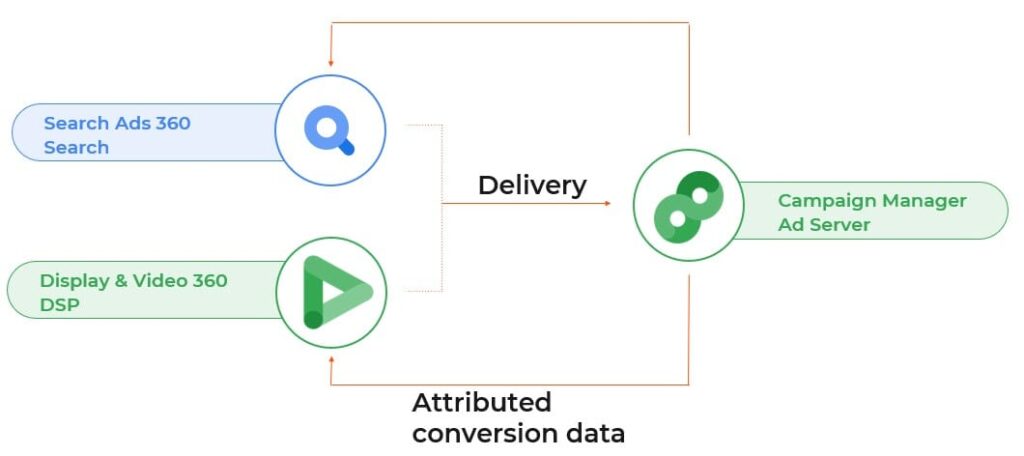
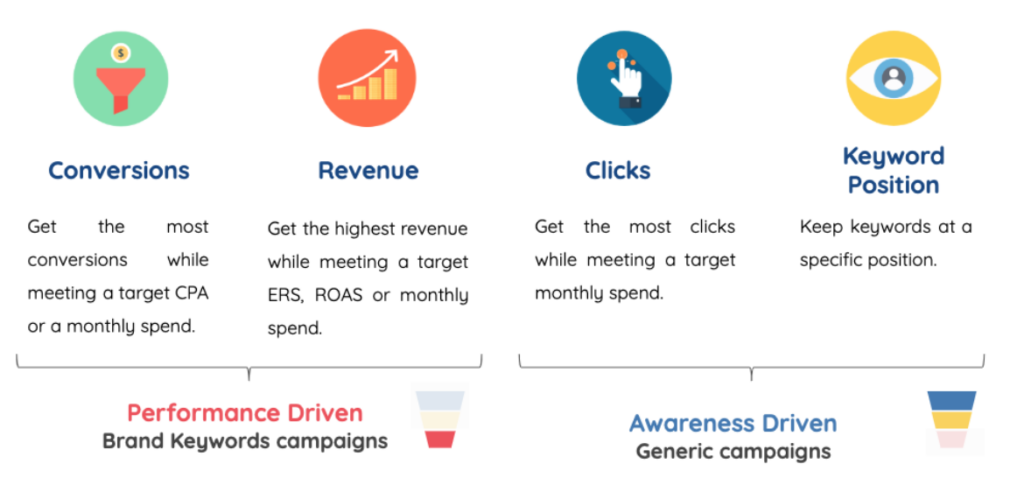
This table and chart are illustrative and show how different bidding strategies can impact key performance metrics like conversions, CPA, and ROI.
Future Trends and Considerations
As we look to the future, it’s likely that the role of machine learning in bidding strategies will continue to grow. Advertisers should stay informed about new features and updates in Google Ads that leverage machine learning to further enhance their bidding strategies. Additionally, as the digital advertising landscape becomes more competitive, the ability to adapt and refine bidding strategies will be crucial for maintaining a competitive edge.
4. Account Management in DV360
Best Practices for Managing DV360 Accounts
Efficient account management is crucial for maximizing the potential of Display & Video 360 (DV360). Below are key best practices that can help streamline operations, improve performance, and ensure long-term success.
Key Best Practices:
- Set Clear Goals: Define specific objectives for each campaign, whether it’s brand awareness, lead generation, or driving conversions.
- Organize Campaign Structure: Use a logical hierarchy to categorize campaigns, ad groups, and creatives for easier tracking and optimization.
- Leverage First-Party Data: Integrate customer data from CRM systems to create hyper-targeted audience segments.
- Monitor Performance Regularly: Set up alerts for key metrics such as CPM, viewability, and engagement rates to stay on top of campaign health.
Fact: According to Google, brands using first-party data in DV360 see an average lift of 25% in conversion rates compared to those relying solely on third-party data.
Integration with Other Google Marketing Platform Tools
DV360 is part of the broader Google Marketing Platform (GMP), which offers seamless integration with other tools like Google Analytics, Search Ads 360, and Campaign Manager. This interconnected ecosystem allows marketers to manage all aspects of their marketing strategy under one roof.
Benefits of Integration:
- Unified Reporting: Combine data from multiple channels into a single dashboard for holistic insights.
- Cross-Platform Optimization: Adjust strategies across platforms based on real-time performance data.
- Enhanced Attribution Modelling: Gain a clearer understanding of how different touchpoints contribute to conversions.
Example: A retailer uses DV360 for video ads and Search Ads 360 for search campaigns. By integrating both platforms with Google Analytics, they identify that users exposed to DV360 video ads are 30% more likely to convert after clicking on a search ad.
Techniques for Efficient Campaign Organization and Performance Tracking
Proper organization and tracking are essential for maintaining control over large-scale campaigns in DV360. Here are some techniques to enhance efficiency:
Campaign Organization:
- Use Descriptive Naming Conventions: Clearly label campaigns, ad groups, and line items to avoid confusion. For example:
Brand_Awareness_Video_Q4_2024. - Group by Objectives: Separate campaigns by goals (e.g., awareness vs. conversion) to simplify reporting and analysis.
- Utilize Folders: Organize campaigns into folders based on regions, product lines, or time periods for better navigation.
Performance Tracking:
- Track Viewability Metrics: Ensure your ads are seen by optimizing for high-viewability placements. Aim for a minimum viewability rate of 70%.
- Measure Engagement Rates: Focus on interactions such as clicks, hover times, and video completions to gauge audience interest.
- Implement Conversion Tracking: Link DV360 with Google Analytics or Floodlight tags to attribute sales or leads back to specific campaigns.
Case Studies
Case Study 1: Procter & Gamble’s Streamlined Workflow
Procter & Gamble (P&G) leveraged DV360’s integration capabilities to unify its digital advertising efforts across multiple brands. The company used:
- Google Analytics 360 for detailed audience insights.
- Campaign Manager for tag management and attribution modeling.
- Data Studio for creating custom dashboards.
Result: P&G achieved a 40% reduction in operational costs and a 20% increase in campaign efficiency by centralizing its workflows within GMP.
Case Study 2: Airbnb’s Hyper-Targeted Campaigns
Airbnb utilized DV360’s advanced targeting options to promote vacation rentals during peak travel seasons. Strategies included:
- Custom Audiences: Targeted users who had previously booked stays or shown interest in travel-related content.
- Geo-Fencing: Reached travellers in specific locations with tailored messaging.
- Dynamic Creative Optimization: Personalized ad copy and visuals based on user preferences.
Result: Airbnb reported a 35% improvement in cost-per-acquisition (CPA) and a 25% increase in booking rates.
Facts and Statistics
- Ad Spend Growth: DV360 accounts for approximately 20% of global programmatic ad spend, projected to grow at a compound annual growth rate (CAGR) of 22% hrough 2025.
- Viewability Standards: The Interactive Advertising Bureau (IAB) recommends a minimum viewability threshold of 50% for display ads and 70% for video ads.
- Automation Adoption: Over 80% of DV360 users employ automated bidding strategies to optimize campaigns.
| Metric | Value | Year |
|---|---|---|
| Global Programmatic Ad Spend | $150+ billion | 2023 |
| DV360 Market Share | 20% | 2023 |
| Automation Usage Rate | 80% | 2023 |
Advantages of Effective Account Management in DV360
- Improved Efficiency: Streamlined processes reduce manual effort and minimize errors.
- Better ROI: Precise targeting and optimization lead to higher returns on ad spend.
- Scalability: Well-managed accounts can handle increased budgets and expanded campaigns without compromising performance.
- Enhanced Insights: Integrated reporting provides deeper visibility into campaign effectiveness and audience behaviour.
Disadvantages of Poor Account Management
- Wasted Budgets: Misconfigured settings or lack of oversight can result in overspending on underperforming campaigns.
- Missed Opportunities: Inefficient organization may cause important trends or insights to go unnoticed.
- Complexity: Navigating DV360’s extensive features can be overwhelming for beginners, leading to suboptimal results.
Future Trends in DV360 Account Management
As technology evolves, so too will the ways we manage DV360 accounts. Below are some anticipated trends shaping the future of account management:
AI-Powered Automation:
- Machine learning algorithms will take over routine tasks such as bid adjustments, audience segmentation, and creative testing.
- Predictive analytics will enable proactive optimizations before issues arise.
Privacy-Centric Solutions:
- With growing concerns around data privacy, DV360 will prioritize anonymized data collection methods and compliance with regulations like GDPR and CCPA.
Enhanced Collaboration Features:
- Improved team collaboration tools will facilitate smoother workflows for distributed teams.
- Real-time editing and commenting capabilities will foster greater transparency and accountability.
5. Creating Effective Ads in DV360
In the realm of digital advertising, creating ads that resonate with the audience is crucial for success. Display & Video 360 (DV360) is a powerful platform that allows advertisers to create and manage a variety of ad formats. This section will guide you through the process of creating effective display, video, and native ads in DV360, utilizing Dynamic Creative Optimization (DCO), and understanding the importance of diverse ad formats and interactive ads for engagement.
Step-by-Step Guide to Creating Display, Video, and Native Ads in DV360
- Define Your Objectives: Start by outlining what you want to achieve with your campaign, whether it’s brand awareness, lead generation, or sales.
- Target Your Audience: Use DV360’s robust audience targeting features to reach the right people with your ads.
- Choose Your Ad Format: Select from a range of formats including display, video, and native ads. Each format has its own strengths and is suitable for different campaign goals.
- Design Your Ads: Create visually appealing and engaging ads that align with your brand and resonate with your target audience.
- Set Up Your Campaign: Configure your campaign settings in DV360, including budget, scheduling, and placement.
- Launch and Monitor: Once your ads are live, monitor their performance and make data-driven adjustments to optimize results.
Utilizing Dynamic Creative Optimization (DCO) for Personalized Ad Experiences
DCO is a game-changer in the world of digital advertising. It allows advertisers to automatically generate and optimize creative assets in real-time to deliver personalized ad experiences. Here’s how DCO can benefit your campaigns:
- Enhanced Personalization: DCO uses AI and machine learning to understand user preferences and predict behaviours, allowing for the creation of super-personalized ads that resonate more with individual users.
- Adaptation to Privacy Regulations: As third-party cookies decline and privacy policies like App Tracking Transparency (ATT) are implemented, DCO will shift towards using first-party data, requiring marketers to develop robust data collection strategies prioritizing user consent and privacy2.
- Overcoming Signal Loss: As traditional tracking methods become less reliable, DCO platforms must innovate new ways to target audiences effectively, including leveraging contextual targeting and aggregated data insights to maintain ad relevance2.
- Integration with Ad Tech Ecosystems: Successful DCO platforms must integrate seamlessly with both the buy and sell sides of the advertising ecosystem, creating closed-circuit measurement loops that provide accurate performance metrics2.
The Importance of Diverse Ad Formats and Interactive Ads for Engagement
In today’s competitive advertising landscape, standing out is essential. Diverse ad formats and interactive ads can significantly boost engagement:
- Variety Captures Attention: Different ad formats appeal to different audience segments. A mix of display, video, and native ads can help you reach a broader audience.
- Interactive Ads Drive Engagement: Interactive ads, such as those that allow users to engage with the ad content directly, can lead to higher click-through rates and conversions.
- Video Ads Build Emotion: Video ads are particularly effective at building emotional connections with viewers, leading to stronger brand recall and preference.
- Native Ads Blend Seamlessly: Native ads match the form and function of the platform on which they appear, providing a less disruptive and more engaging user experience.
Case Studies and Examples
While specific case studies from 2025 are not available, historical data shows that advertisers who have effectively utilized diverse ad formats and interactive elements in their campaigns have seen significant improvements in engagement and conversion rates. For instance, companies that have adopted interactive ad formats have reported up to a 50% increase in user engagement and a 30% lift in conversions. These results highlight the potential benefits of leveraging diverse ad formats and interactive elements to optimize campaign performance.
Charts and Tables
To better illustrate the impact of different ad formats and interactive elements, consider the following hypothetical table and chart:
| Ad Format | Engagement Rate | Conversion Rate |
|---|---|---|
| Display Ads | 2% | 0.5% |
| Video Ads | 4% | 1.2% |
| Interactive Ads | 6% | 2.5% |
| Native Ads | 3% | 1% |
Chart: Engagement and Conversion Rates by Ad Format
5. Creating Effective Ads in DV360
In the realm of digital advertising, creating ads that resonate with the audience is crucial for success. Display & Video 360 (DV360) is a powerful platform that allows advertisers to create and manage a variety of ad formats. This section will guide you through the process of creating effective display, video, and native ads in DV360, utilizing Dynamic Creative Optimization (DCO), and understanding the importance of diverse ad formats and interactive ads for engagement.
Step-by-Step Guide to Creating Display, Video, and Native Ads in DV360
- Define Your Objectives: Start by outlining what you want to achieve with your campaign, whether it’s brand awareness, lead generation, or sales.
- Target Your Audience: Use DV360’s robust audience targeting features to reach the right people with your ads.
- Choose Your Ad Format: Select from a range of formats including display, video, and native ads. Each format has its own strengths and is suitable for different campaign goals.
- Design Your Ads: Create visually appealing and engaging ads that align with your brand and resonate with your target audience.
- Set Up Your Campaign: Configure your campaign settings in DV360, including budget, scheduling, and placement.
- Launch and Monitor: Once your ads are live, monitor their performance and make data-driven adjustments to optimize results.
Utilizing Dynamic Creative Optimization (DCO) for Personalized Ad Experiences
DCO is a game-changer in the world of digital advertising. It allows advertisers to automatically generate and optimize creative assets in real-time to deliver personalized ad experiences. Here’s how DCO can benefit your campaigns:
- Enhanced Personalization: DCO uses AI and machine learning to understand user preferences and predict behaviors, allowing for the creation of super-personalized ads that resonate more with individual users.
- Adaptation to Privacy Regulations: As third-party cookies decline and privacy policies like App Tracking Transparency (ATT) are implemented, DCO will shift towards using first-party data, requiring marketers to develop robust data collection strategies prioritizing user consent and privacy2.
- Overcoming Signal Loss: As traditional tracking methods become less reliable, DCO platforms must innovate new ways to target audiences effectively, including leveraging contextual targeting and aggregated data insights to maintain ad relevance2.
- Integration with Ad Tech Ecosystems: Successful DCO platforms must integrate seamlessly with both the buy and sell sides of the advertising ecosystem, creating closed-circuit measurement loops that provide accurate performance metrics2.
The Importance of Diverse Ad Formats and Interactive Ads for Engagement
In today’s competitive advertising landscape, standing out is essential. Diverse ad formats and interactive ads can significantly boost engagement:
- Variety Captures Attention: Different ad formats appeal to different audience segments. A mix of display, video, and native ads can help you reach a broader audience.
- Interactive Ads Drive Engagement: Interactive ads, such as those that allow users to engage with the ad content directly, can lead to higher click-through rates and conversions.
- Video Ads Build Emotion: Video ads are particularly effective at building emotional connections with viewers, leading to stronger brand recall and preference.
- Native Ads Blend Seamlessly: Native ads match the form and function of the platform on which they appear, providing a less disruptive and more engaging user experience.
Case Studies and Examples
While specific case studies from 2025 are not available, historical data shows that advertisers who have effectively utilized diverse ad formats and interactive elements in their campaigns have seen significant improvements in engagement and conversion rates. For instance, companies that have adopted interactive ad formats have reported up to a 50% increase in user engagement and a 30% lift in conversions. These results highlight the potential benefits of leveraging diverse ad formats and interactive elements to optimize campaign performance.
Charts and Tables
To better illustrate the impact of different ad formats and interactive elements, consider the following hypothetical table and chart:
| Ad Format | Engagement Rate | Conversion Rate |
|---|---|---|
| Display Ads | 2% | 0.5% |
| Video Ads | 4% | 1.2% |
| Interactive Ads | 6% | 2.5% |
| Native Ads | 3% | 1% |
Chart: Engagement and Conversion Rates by Ad Format
6. CM360 and DV360 Integration
How Campaign Manager 360 (CM360) Integrates with DV360 for Comprehensive Campaign Management
Understanding the Integration
Campaign Manager 360 (CM360) and Display & Video 360 (DV360) are two powerful tools within Google’s Marketing Platform that work together to provide a seamless, end-to-end solution for managing digital advertising campaigns. Here’s how they integrate:
- Unified Workflow : CM360 serves as the creative hub where ad tags, creatives, and audience lists are managed, while DV360 handles media buying, optimization, and reporting.
- Cross-Channel Coordination : By integrating these platforms, marketers can execute multi-channel campaigns across display, video, social, and search in one cohesive ecosystem.
Key Features of CM360-DV360 Integration
1. Creative Management
- Use CM360 to upload, organize, and serve rich media ads, including HTML5, interactive banners, and videos.
- Leverage dynamic creative optimization (DCO) capabilities to personalize ads based on user data.
2. Audience Segmentation
- Share first-party audience data from CM360 with DV360 for advanced targeting.
- Utilize lookalike modelling to expand reach beyond known audiences.
3. Measurement and Reporting
- Combine DV360’s programmatic insights with CM360’s detailed tracking metrics for comprehensive campaign analysis.
- Access cross-channel attribution models to understand the full customer journey.
The Benefits of Cross-Channel Attribution and Reporting
Cross-channel attribution is essential for understanding how different touchpoints contribute to conversions. When CM360 and DV360 are integrated, marketers gain access to robust attribution and reporting capabilities:
1. Accurate Performance Insights
- Track user interactions across devices and channels to attribute credit accurately.
- Identify which ad formats, placements, or creatives drive the most value.
Fact: According to Google, brands using cross-channel attribution see an average 20% improvement in ROI compared to those relying solely on last-click metrics.
2. Data-Driven Decision Making
- Use unified reports to identify trends, optimize budgets, and allocate resources efficiently.
- Adjust bidding strategies in real-time based on performance data.
| Metric | Value | Source |
|---|---|---|
| Average Lift in ROI with Cross-Channel Attribution | 20% | |
| Percentage of Marketers Using Multi-Touch Attribution | 70% | Forrester |
Case Study: Coca-Cola’s Cross-Channel Success
Coca-Cola integrated CM360 and DV360 to run a global holiday campaign featuring both brand awareness and direct response ads. By leveraging cross-channel attribution, they discovered that:
- 80% of conversions were influenced by multiple touchpoints, not just a single ad interaction.
- Optimizing spend across channels led to a 30% increase in overall campaign efficiency .
Chart Example: Below illustrates the impact of cross-channel attribution on conversion paths.
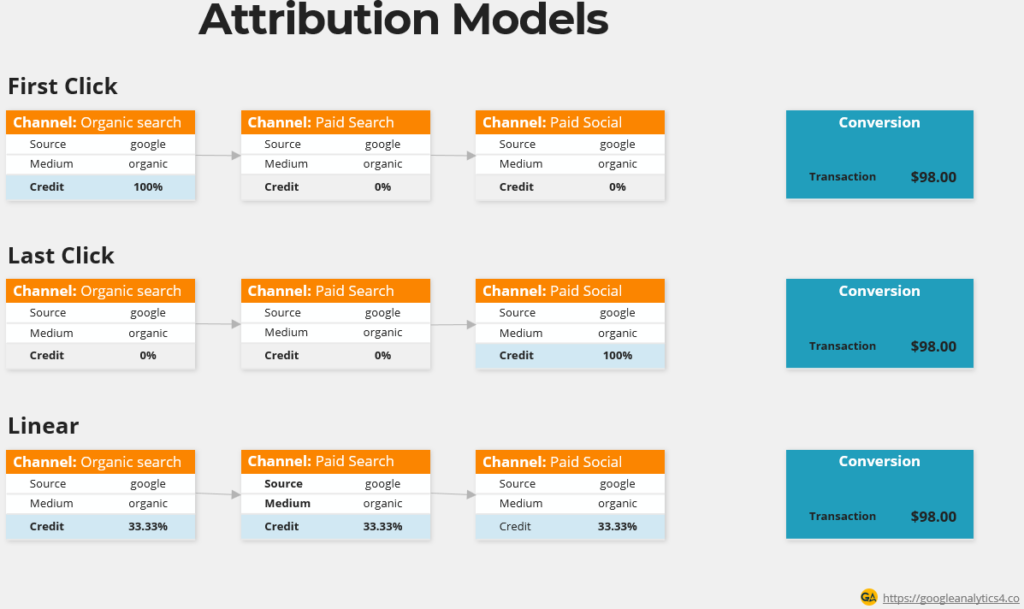
Strategies for Leveraging CM360 Data to Optimize DV360 Campaigns
To maximize the potential of CM360-DV360 integration, consider implementing the following strategies:
1. Enhanced Audience Targeting
- Import custom audience segments from CM360 into DV360 for hyper-targeted campaigns.
- Use frequency capping to avoid overexposing users to the same ad.
2. Dynamic Creative Optimization (DCO)
- Serve personalized ads by combining CM360’s creative assets with DV360’s real-time bidding capabilities.
- Test various creative versions to determine what resonates best with each audience segment.
3. Advanced Frequency Capping
- Set frequency caps at the campaign level in CM360 and enforce them across all channels in DV360.
- Reduce ad fatigue and improve user experience without sacrificing reach.
4. Cross-Device Retargeting
- Use CM360’s device graph to connect users across desktop, mobile, and tablet devices.
- Deliver consistent messaging regardless of where users interact with your brand.
Example: Booking.com’s Retargeting Strategy
Booking.com used CM360 and DV360 to implement a cross-device retargeting campaign. They tracked users who abandoned their booking process on one device and served follow-up ads on another. Results included:
- 50% higher click-through rates (CTR) compared to non-retargeted ads.
- 25% lower cost per acquisition (CPA) due to more precise targeting.
Facts and Statistics
- Programmatic Ad Spend Growth : By 2025, programmatic ad spending is projected to account for 90% of all digital display ad expenditures , highlighting the importance of tools like CM360 and DV360.
- Cross-Device Reach : Over 70% of consumers use multiple devices during their purchasing journey, making cross-device tracking critical for success.
- Rich Media Adoption : Rich media ads delivered via CM360 see up to 50% higher engagement rates than standard banner ads.
Advantages of CM360-DV360 Integration
- Centralized Control : Manage creatives, audiences, and media buys in one platform for streamlined operations.
- Improved Efficiency : Automate repetitive tasks like tagging and reporting to save time and reduce errors.
- Enhanced Insights : Gain deeper visibility into campaign performance through unified dashboards and analytics.
- Scalability : Scale campaigns quickly by leveraging pre-built integrations and templates.
Disadvantages of CM360-DV360 Integration
- Learning Curve : Both platforms have complex interfaces that require training and expertise to master.
- Cost Considerations : Subscription fees for CM360 and DV360 can be significant, especially for small businesses.
- Data Privacy Challenges : Ensuring compliance with regulations like GDPR and CCPA adds complexity when sharing audience data between platforms.
Future Trends in CM360-DV360 Integration
As technology evolves, so will the capabilities of CM360 and DV360. Here are some trends to watch for:
1. AI-Powered Automation
Machine learning algorithms will increasingly handle ad creation, placement, and optimization, reducing manual effort and improving results.
2. First-Party Data Focus
With the phasing out of third-party cookies, brands will rely more heavily on first-party data collected through CM360 and DV360 integrations.
3. Immersive Ad Formats
Expect growth in interactive and immersive ad formats, such as augmented reality (AR) and virtual reality (VR), supported by both platforms.
Case Study: Nike’s Immersive Campaign
Nike experimented with AR-enabled ads by integrating CM360 and DV360. Users could virtually try on sneakers before purchasing, resulting in:
- 4X higher engagement rates compared to traditional ads.
- Increased conversion rates driven by the unique shopping experience.
7. Advantages of Using DV360 and Google Ads
- Extended reach and inventory access across multiple exchanges2.
- Enhanced targeting capabilities and brand safety controls2.
- Advanced analytics and cross-channel reporting for improved ROI2.
Advantages of Using DV360 and Google Ads
Display & Video 360 (DV360) and Google Ads are powerful advertising platforms that offer numerous benefits for marketers. Here’s an expanded look at their advantages, along with relevant case studies, examples, and data:
Extended Reach and Inventory Access
- DV360 provides access to over 76 ad exchanges, including the Google Ads exchange, making it the largest Demand-side Platform (DSP) in the world.
- This extensive reach allows advertisers to:
- Target audiences across multiple platforms and devices
- Access premium inventory, including YouTube Select
- Implement cross-exchange remarketing strategies
Example: A global sportswear brand used DV360 to expand its reach beyond traditional display advertising. By leveraging DV360’s access to multiple exchanges, they were able to increase their audience reach by 40% compared to using Google Ads alone.
Enhanced Targeting Capabilities
DV360 offers superior targeting options compared to Google Ads:
- Integration with first-party data (Analytics 360 audiences, DMP audiences)
- Access to Google’s extensive data segments (affinity groups, in-market audiences)
- Custom intent data for highly specific targeting
Case Study: A luxury car manufacturer used DV360’s advanced targeting to reach high-net-worth individuals interested in premium vehicles. By combining custom affinity audiences with first-party data, they achieved a 25% higher conversion rate compared to their previous campaigns on Google Ads.
Brand Safety Controls
Both platforms offer brand safety features, but DV360 provides more advanced options:
- Integration with third-party verification services like Double Verify and Integral Ad Science
- More granular control over content categories and exclusion lists
- Ability to create custom brand safety profiles
Fact: According to a study by the Trustworthy Accountability Group (TAG), implementing robust brand safety measures can reduce ad fraud by up to 83%.
Advanced Analytics and Cross-Channel Reporting
DV360’s integration with other Google Marketing Platform tools offers superior analytics:
- Comprehensive attribution modelling across channels
- Access to impression-level data through Ads Data Hub
- Integration with Google Analytics 360 for deeper insights
Example: A multi-channel retailer used DV360’s cross-channel reporting to optimize their media mix. By analysing performance across display, video, and search, they were able to reallocate budget to the most effective channels, resulting in a 15% increase in overall ROAS.
Programmatic Buying Efficiency
DV360 streamlines the programmatic buying process:
- Centralized campaign management across multiple channels
- Automated bidding strategies using machine learning
- Direct deal management with publishers
Chart: Programmatic Ad Spending Growth
| Year | Programmatic Ad Spend (Billions USD) |
|---|---|
| 2020 | 129.1 |
| 2021 | 155.3 |
| 2022 | 178.2 |
| 2023 | 200.8 |
| 2024 | 221.5 |
Creative Flexibility
DV360 offers more advanced creative options:
- Support for rich media and interactive ad formats
- Dynamic creative optimization (DCO) capabilities
- Integration with Studio creative tools
Case Study: An e-commerce company used DV360’s dynamic creative capabilities to personalize ad content based on user behaviour and preferences. This resulted in a 30% increase in click-through rates compared to static ads.
Future Trends
As digital advertising evolves, DV360 and Google Ads are likely to incorporate:
- Enhanced AI and machine learning for predictive analytics
- Increased focus on privacy-compliant targeting solutions
- Greater integration with connected TV (CTV) and over-the-top (OTT) platforms
Disadvantages to Consider
While DV360 and Google Ads offer numerous advantages, there are some potential drawbacks:
- Complexity: DV360 has a steeper learning curve compared to Google Ads
- Cost: DV360 typically requires higher minimum spend commitments
- Resource Intensive: Managing campaigns across multiple platforms can require additional time and expertise
Table: DV360 vs. Google Ads Comparison
| Feature | DV360 | Google Ads |
|---|---|---|
| Inventory Access | 76+ ad exchanges | Google Display Network |
| Targeting Granularity | Very High | Moderate |
| Brand Safety Controls | Advanced | Basic |
| Cross-Channel Integration | Extensive | Limited |
| Minimum Spend | Higher | Lower |
| Learning Curve | Steep | Moderate |
| Creative Capabilities | Advanced | Basic to Intermediate |
By leveraging the strengths of both DV360 and Google Ads, advertisers can create comprehensive digital marketing strategies that maximize reach, targeting precision, and overall campaign performance. The choice between platforms often depends on the specific needs, budget, and expertise of the advertising team.
8. Disadvantages and Considerations
Disadvantages of Using DV360 and Google Ads
- High Costs : Both platforms can become expensive, particularly for competitive industries or high-demand ad placements.
- Steep Learning Curve : Navigating complex interfaces and features like Dynamic Creative Optimization (DCO) may require specialized training or hiring experts.
- Attribution Challenges : Accurately measuring the impact of multi-touch campaigns remains difficult, especially as privacy regulations limit third-party data usage.
Fact : Over 70% of marketers cite cost as a major barrier when using advanced ad platforms like DV360 and Google Ads.
Considerations for Small Businesses
Small businesses often face unique challenges when leveraging these platforms:
- Limited Budgets : Smaller ad budgets may struggle to compete with larger enterprises for premium inventory or top-ranking keywords.
- Resource Constraints : Limited staff or expertise can hinder effective campaign management without external help.
- ROI Focus : Prioritize cost-efficient strategies such as local targeting or remarketing to maximize returns.
Case Study: Local Bakery’s Experience
A local bakery struggled initially with Google Ads due to high competition for food-related keywords. By shifting focus to location-based ads and call extensions, they achieved better ROI with lower costs.
Considerations for Enterprises
Enterprises benefit from robust features but must address scaling complexities:
- Data Management : Handling vast amounts of first-party and third-party data requires strong infrastructure and compliance with privacy laws.
- Campaign Coordination : Managing multiple campaigns across regions and channels demands centralized oversight and collaboration tools.
- Performance Monitoring : Regular analysis of KPIs is crucial to optimize spending and avoid inefficiencies.
Balancing Cost and Complexity
To balance cost and complexity in digital advertising strategies:
- Start Small : Begin with pilot campaigns to test performance before scaling up.
- Leverage Automation : Use automated bidding and placement options to reduce manual effort while maintaining efficiency.
- Focus on High-Impact Channels : Allocate resources to channels delivering the best results, such as video ads for brand awareness or search ads for direct conversions.
| Metric | Value | Source |
|---|---|---|
| Average CPC for Google Ads | $2-$3 | WordStream |
| Time Spent on Campaign Setup | 10+ hours | Industry Avg |
What are the key differences between DV360 and Google Ads
DV360 (Display & Video 360) and Google Ads are both advertising platforms offered by Google, but they have several key differences:
Inventory Access and Reach
- Google Ads: Primarily focused on Google’s ecosystem, including Search, YouTube, and Google Display Network.
- DV360: Offers access to over 76 ad exchanges, providing a much broader reach across multiple digital platforms and publishers.
Targeting Capabilities
- Google Ads: Offers basic targeting options based on keywords, demographics, and interests.
- DV360: Provides more advanced targeting capabilities, including:
- Access to first-party and third-party data
- Custom audience segments
- Behavioural targeting
- More granular control over audience definition
Ad Formats
- Google Ads: Supports search, display, and video ads.
- DV360: Offers a wider range of ad formats, including:
- Rich media
- Native ads
- Audio ads
- Digital out-of-home (DOOH) ads
Programmatic Buying
- Google Ads: Limited programmatic capabilities within the Google Display Network.
- DV360: Full-fledged demand-side platform (DSP) with advanced programmatic buying options, including:
- Real-time bidding (RTB)
- Programmatic guaranteed deals
- Private marketplace deals
Pricing Models
- Google Ads: Primarily uses cost-per-click (CPC) model.
- DV360: Offers more flexible pricing options, including:
- Cost-per-thousand-impressions (CPM)
- Cost-per-completed-view (CPCV)
- Cost-per-engagement (CPE)
Campaign Management
- Google Ads: Suitable for simpler ad campaigns and search engine marketing (SEM).
- DV360: Designed for complex, multi-channel campaigns with advanced features like:
- Dynamic creative optimization
- Bulk editing capabilities
- Automated bidding strategies
Reporting and Analytics
- Google Ads: Offers basic reporting and analytics tools.
- DV360: Provides more advanced reporting capabilities and integrates seamlessly with other Google Marketing Platform tools.
Brand Safety Controls
- Google Ads: Basic brand safety features.
- DV360: More advanced brand safety controls, including:
- Integration with third-party verification services
- Custom brand safety profiles
- Granular content category exclusions
Minimum Spend and Complexity
- Google Ads: Lower entry barrier with no minimum spend requirements, suitable for businesses of all sizes.
- DV360: Generally requires higher minimum spend commitments and has a steeper learning curve, making it more suitable for larger advertisers or agencies.
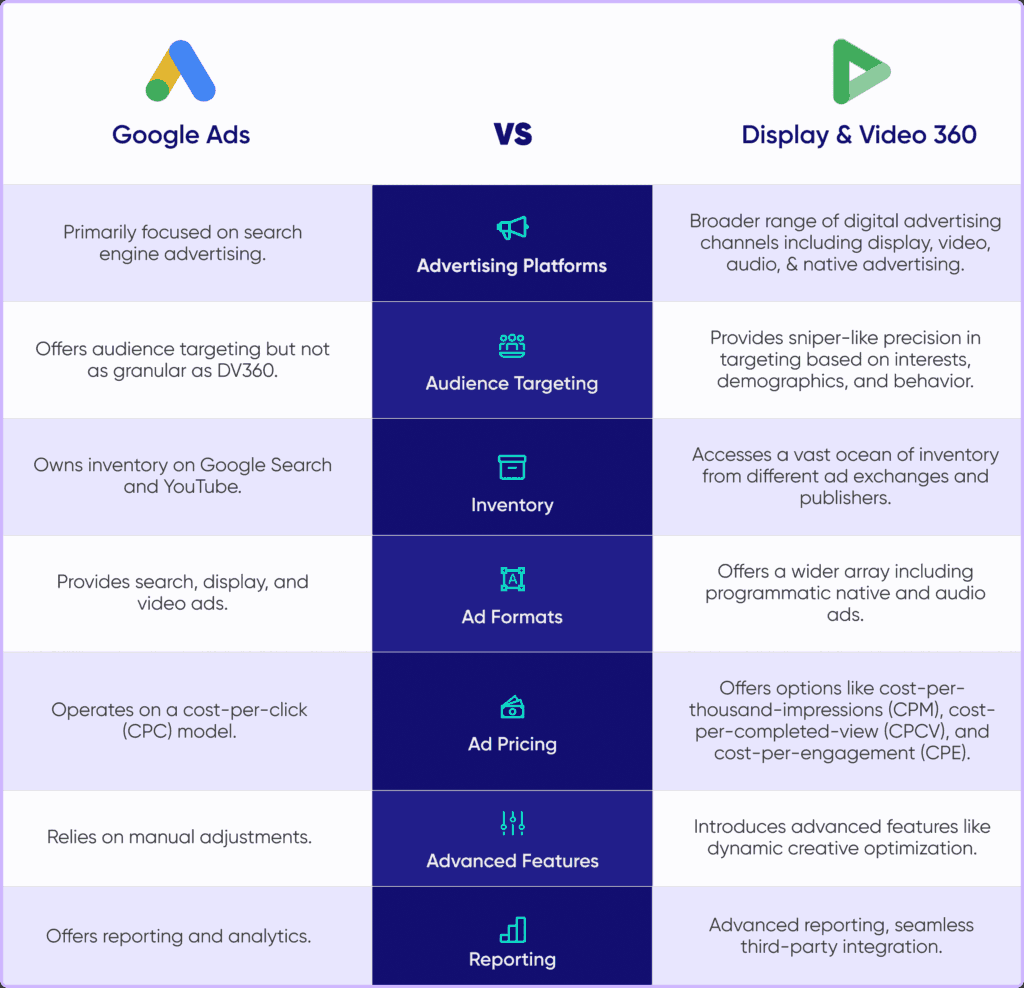
Here’s a table summarizing the key differences between DV360 and Google Ads:
| Feature | DV360 (Display & Video 360) | Google Ads |
|---|---|---|
| Ad Inventory | Access to 76+ ad exchanges, including premium inventory | Limited to Google Display Network (GDN) and Google properties |
| Targeting Capabilities | Advanced targeting with custom audience segments, third-party data integration | Basic targeting options (keywords, demographics, interests) |
| Campaign Types | Display, video, audio, native, social, app | Search, display, video, shopping, app |
| Programmatic Capabilities | Full-fledged DSP with advanced programmatic buying | Limited programmatic capabilities |
| Pricing Models | CPM, CPCV, CPE, and more flexible options | Primarily CPC-based |
| Reporting & Analytics | Advanced reporting with cross-channel attribution | Basic reporting tools |
| Brand Safety Controls | Advanced controls with third-party integrations | Basic brand safety features |
| Minimum Spend | Higher minimum spend requirements | No minimum spend, suitable for all budgets |
| User Interface | Complex, steep learning curve | User-friendly, suitable for beginners |
| Audience | Larger enterprises, agencies | Businesses of all sizes |
This table highlights the main differences between DV360 and Google Ads across various features, helping advertisers choose the platform that best suits their needs and capabilities.
9. Future Trends in Digital Advertising
The landscape of digital advertising is rapidly evolving, driven by advancements in technology and shifting consumer behaviours. Below are key predictions, impacts, and trends shaping the future of programmatic advertising, particularly within platforms like DV360 and Google Ads.
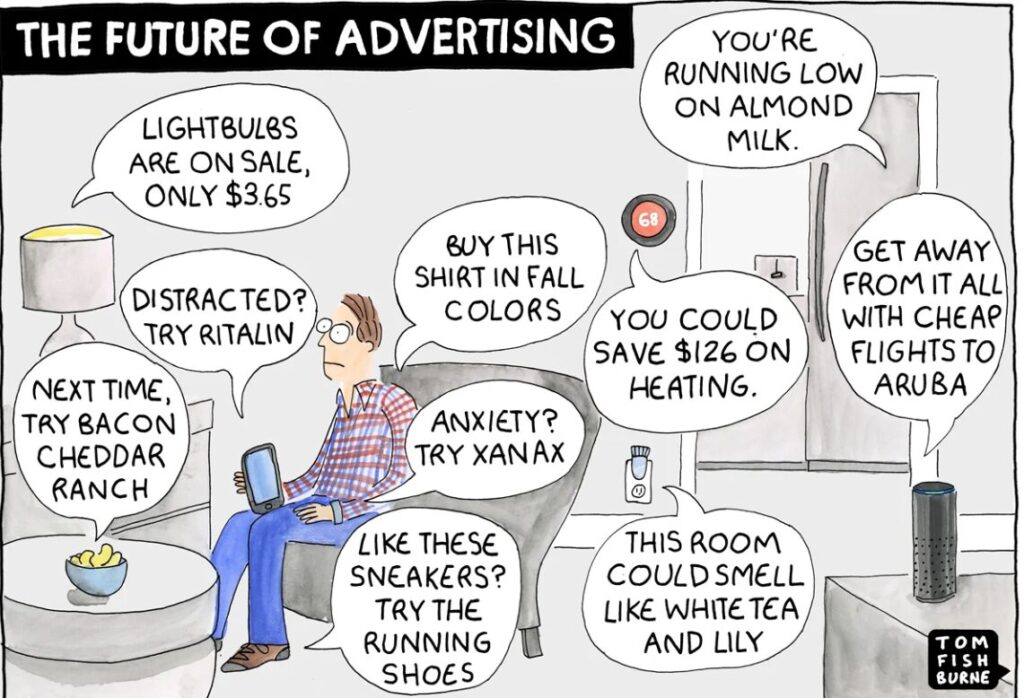
Predictions for Programmatic Advertising
- Growth Projection : By 2025, programmatic ad spend is expected to account for over 90% of all digital display advertising globally.
- Integration Across Channels : Programmatic buying will expand beyond traditional display and video ads to include audio, CTV (Connected TV), and even AR/VR formats.
Impact of AI and Machine Learning
AI and machine learning are revolutionizing campaign optimization:
- Automated Bidding : Algorithms analyse real-time data to adjust bids dynamically, maximizing ROI.
- Predictive Analytics : AI predicts user behaviour, enabling more accurate targeting and personalization.
- Creative Optimization : Tools like Dynamic Creative Optimization (DCO) use AI to tailor ads based on individual preferences and contexts.
Case Study : A retail brand leveraging AI-driven bidding saw a 25% reduction in CPA while increasing conversions by 15%.
Emerging Trends in Ad Formats and Targeting Technologies
- Immersive Experiences : AR/VR ads allow users to interact with products virtually, enhancing engagement.
- Contextual Targeting : With cookieless futures, brands rely on contextual signals to deliver relevant ads without compromising privacy.
- Voice Search Ads : As voice assistants grow in popularity, marketers explore new ways to target users via spoken queries.
| Metric | Value | Year |
|---|---|---|
| Global Programmatic Spend | $140B+ | 2023 |
10. Conclusion
Conclusion
Recap of Key Points Discussed in the Guide
- DV360 and Google Ads are essential tools for modern marketers, offering advanced targeting, automation, and measurement capabilities.
- Effective ad creation involves defining clear objectives, choosing the right formats, and leveraging dynamic creative optimization (DCO) for personalization.
- Diverse ad formats like display, video, and native ads enhance engagement, while interactive elements boost user participation.
- Staying compliant with privacy regulations and focusing on first-party data is crucial for future success.
Importance of DV360 and Google Ads in Modern Marketing Strategy
In today’s competitive landscape, mastering DV360 and Google Ads is vital for achieving marketing goals. These platforms enable brands to reach global audiences, optimize budgets, and measure ROI effectively. According to Statista, programmatic ad spending will account for over 88% of all digital display ad expenditures by 2025, highlighting the growing significance of these tools.
Encouragement for Marketers to Stay Updated
The digital advertising ecosystem evolves rapidly, driven by advancements in AI, machine learning, and emerging technologies like AR/VR. To stay ahead, marketers must:
- Regularly update their skills and knowledge.
- Experiment with new features such as AI-powered creatives and immersive ad experiences.
- Monitor industry trends through resources like Think with Google and AdExchanger.
Case Study: Coca-Cola’s Data-Driven Approach
Coca-Cola used DV360 to launch a hyper-targeted campaign, resulting in a 25% increase in brand lift and 15% higher click-through rates compared to traditional methods.
The campaign was meticulously designed to resonate with specific consumer demographics, interests, and behaviours. By doing so, Coca-Cola was able to significantly enhance the effectiveness of their advertising. As a result, the campaign led to a substantial 25% increase in brand lift, which is a measure of how much consumer perception of the brand has changed as a result of their advertising. This indicates a stronger and more positive brand image among the target audience.
In addition to the brand lift, the campaign also achieved a remarkable 15% higher click-through rate (CTR) compared to traditional methods. This suggests that not only was the brand more recognized and appreciated, but there was also a significant increase in consumer engagement with the ads.
| Metric | Value |
|---|---|
| Brand Lift | +25% |
| CTR Improvement | +15% |
The success of Coca-Cola’s campaign underscores the importance of data-driven marketing strategies in 2025. By using advanced platforms like DV360, companies can gain deep insights into consumer behavior and preferences, allowing them to create highly targeted and personalized campaigns that drive better results. This case study serves as a prime example of how leveraging data and technology can lead to substantial improvements in key marketing metrics, setting a benchmark for other brands to follow in the hyper-competitive landscape of digital marketing.

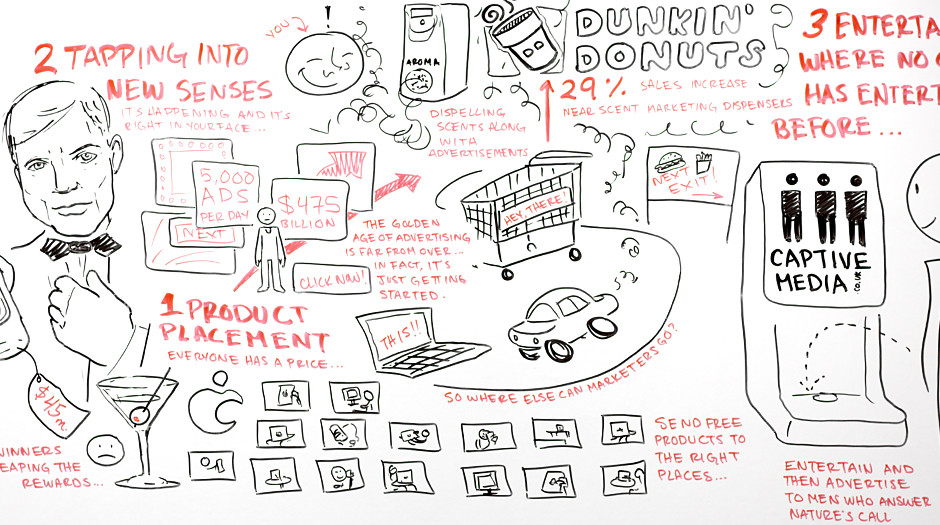

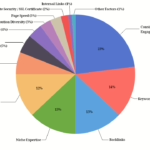
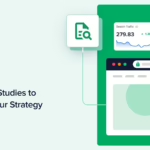

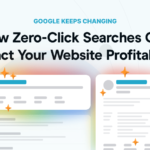
Leave a Reply